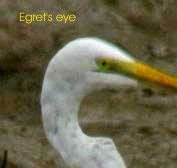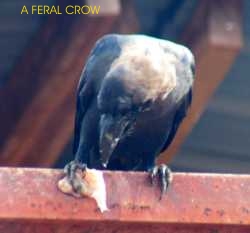|
Satisfied with feasting our eyes at the mudflats, we moved on. Out
from the jetty and onto the bund. It was very
straight running track stretching for just over a kilometer. Coming
from Sungei Buloh the low lying land on the right,
cultivated, slope away from the raised bund,
separated by an irrigation canal. On the left, a
tiny band of forested mangrove trees. During the
couple of hours we spent there, there was hardly a
quiet moment. We were surprised to see the
Straw-headed Bulbul in the mangrove forest, trying
to ascertain whether it was the Grey-capped or the Sunda Pgymy
Woodpecker. Waiting for the Chestnut-winged Cuckoo
to make a re-appearance. Running after the Drongo Cuckoo. The Ashy Drongo, Great Tit and the
Flycatcher were all there, motionless for a while. In total we
counted the sighting 8 pairs of Collared Kingfishers
and 7 Black-capped all by itself.
We
left the bund road just as the clock struck 12
noon. Off we went to Pasir Penanpang for lunch.
The crowd was thin and we had a good meal. After
that, I suggested that we check on the status of
the rice fields. Harvesting was over and now it is
the "wait" to do the next planting in
January. We were there looking for Snipes and also what
the field has to offer at this time of the year.
The usual Bee-eaters and Wood Swallows were there.
This time around there were the Little-ringed
Plover and a passage migrant, the Marsh Sandpiper.
A Cinnamon Bittern flew into the bund just meters
away from us and that was one of my lifers for the
day.
Both destinations were rated as above average. It
was one of the more successful days of birding for
some time to come.
Other
highlights for the day:-
Of special mention today, should be the Great
Egret and Great Tit. Standing alone, it was difficult by
gauging the kink on its neck, to establish whether the
bird was an Intermediate or Great Egret.
|
 |
Now
that we had gone into greater details, we could share
this experiences with you. The Great Egret is most
easily ID through the "S" kink made by the long neck.
Next is to guess the size of the bird and lastly to
differentiate, check the bill and also shape of the head.
That morning we only had the Chinese Egret for
comparison and the "Kink" was sporadically displayed. So
we looked for the eye. The area behind the eye should
extend beyond the eye ball.
Next look
at the picture above, the tibia is of a lighter colour.
All these diagnostic features can be used when comparing
this bird with the Intermediate Egret.
|
|
For a long
time, I had marveled at the fact that some House Crow
are not entirely black. Here is one, having an obviously brown
patch at its neck. That morning, this scavenger turned
thief flew in front of me. Now I confirmed that there is
this sub-species of House Crow.
It
not everyday that we get to hear sweet whistling tune.
That day, we heard a continuous call of what sounds like
a Sunbird, but sweeter and each tune ended with a louder
melodic note. There at 12 o'clock was this Great Tit.
This was the second time, I had followed through an
unfamiliar tune to spot a lifer. The last time was the Mangrove
Whistler. In this respect, Mangrove Birds, less exposed
to human stayed on longer, enabling us to spot them. |
 |
Oblivion to our presence the few |

